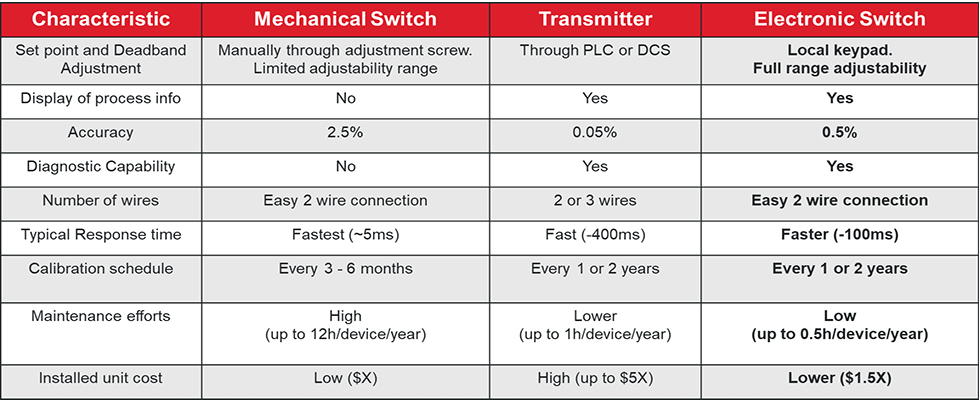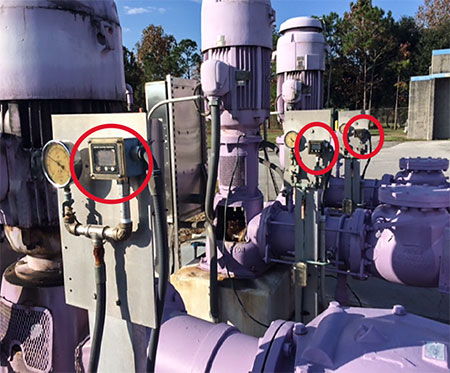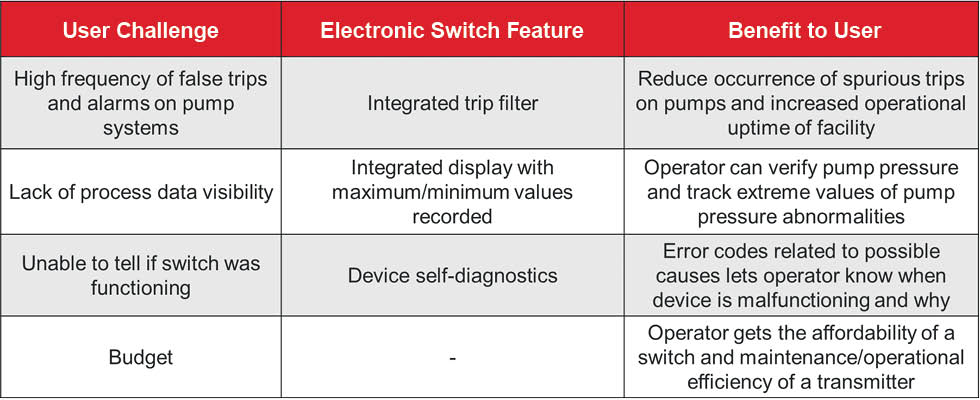
In certain industrial facilities, pumping systems can account for more than 50% of the applications and energy usage. Precise pump control, including alarm and emergency shutdown functions, is critical to a plant operating optimally. While mechanical instrumentation (e.g., pressure, temperature switches) has traditionally been deployed on pumping systems, operators are upgrading to more advanced control and automation technologies (e.g., wireless solutions) so more data can be extracted at the sensor level. The goal of this is to improve plant efficiency. Data has inevitably become the new currency.
Mechanical Switches vs. Electronic Transmitters
Many operators still maintain mechanical switches in their plants as a last line of defense, especially for alarm and emergency shutdown functions. These switches respond quickly (approximately five milliseconds in response time), are easy to operate and are relatively inexpensive compared to process transmitters. Switches can also be wired to these pumping systems for direct emergency shutdown.
There are a few limitations, though. Mechanical switches do not relay any process data and cannot indicate if they are functioning. Maintaining these devices can be laborious, such as taking the units back to the instrument shop and making delicate adjustments, including inspecting, testing, calibrating and setting the trip points. Mechanical switches are also vulnerable to vibration, shock and other stresses common in industrial applications such as pumping systems.
Conversely, transmitters play a vital part in data collection and converting measurement parameters into signals that can be trended and logged through modern control systems. Transmitters deliver an array of benefits such as self-diagnostics, high accuracy (0.05% error or lower) and minimal maintenance (calibration every one or two years).
What is less often acknowledged is upgrading from switches to transmitters may not always benefit the end user. In many applications, replacing a switch with a transmitter is overkill. Not all applications require the high-end accuracy delivered by process transmitters, and the device cost of transmitters (up to five times more than a mechanical switch) may not justify its benefits. Beyond the device cost, installing transmitters may sometimes require a separate power supply, which means additional wiring infrastructure. Furthermore, connecting a transmitter to a programmable logic controller (PLC) requires the additional step of reprogramming switch set points into the ladder logic of the PLC.
Industries’ need for instrumentation simplicity, reliability and data signals the need for a hybrid solution that combines the benefits of mechanical switches and transmitters.
Electronic Switches—A Hybrid Solution
Electronic switches combine the advantages of transmitters and mechanical switches without the downsides. Leading electronic switch brands feature innovative capabilities to meet the vast needs and high demands of an industrial environment. For example, some electronic switches offer plugged port detection.
This capability notifies the operator to clear the process port if it becomes plugged due to process debris buildup, or when a block and bleed valve is accidentally left closed during maintenance. Such abnormalities can be addressed quickly, resulting in increased operational uptime and accurate process and safety monitoring.
One advantage an electronic switch has over both a mechanical switch and transmitter is it allows for field programming of set points and deadband through a keypad on the device. The device does not need to be taken out of service for manual adjustment (compared to a mechanical switch) or have its set points reprogrammed at the PLC level (compared to a transmitter). Image 1 compares a mechanical switch, transmitter and electronic switch.
Benefits of Electronic Switches
Industrial facilities are constantly trying to improve the efficiency of their operations. Electronic switches can deliver several benefits from an efficiency standpoint.
Maintenance efficiency
Operators can spend between four and 12 hours per device per year maintaining a switch. Maintenance includes the labor and time required to inspect, test, calibrate and set the devices. Often, these switches must be removed from the equipment and taken back to the instrument shop for maintenance.
With electronic switches, maintenance can be reduced by up to 90%, as it takes no more than 30 minutes to program the electronic switch, which also does not require frequent calibration. Any calibration or resetting of the device can be done on-site, saving labor. For a small plant with 100 switches, maintenance time can be reduced from 400 hours (50 labor days) to 50 hours (6 labor days).
Operational efficiency
Unlike mechanical switches with components that move relative to each other for actuation (e.g., plungers, springs), electronic switches do not have moving components, making them more vibration resistant. This results in greater reliability due to eliminating false alarms arising from mechanical component shifts and more accurate performance for high-vibration applications like pump systems. Enhanced reliability means better operational uptime.
Cost efficiency
Some electronic switches come with a four to 20 milliamp (mA) output in addition to relay contacts. This means a single electronic switch can replace the functions of a transmitter, switch and gauge. This potentially reduces instrumentation inventory by 66%, as with the number of potential leakage points.
In addition, since an electronic switch has better repeatability and accuracy (in terms of percentage error over full-scale range) than a mechanical switch, it can be used to substitute multiple ranges of mechanical switches and achieve a similar magnitude of performance error. Operators can standardize on a specific model of an electronic switch for the majority of their pump applications, streamlining their instrumentation inventory and cost.
Additionally, from a Management of Change (MoC) perspective, the ability to drop in electronic switches to existing two-wire switch infrastructure makes change management straightforward and hassle-free. Minimal new documents or engineering drawing changes are needed, eliminating the costs associated with MoC.
Case Study
Since its inception, a water treatment facility has used mechanical switches on its pumps for high and low-pressure alarms and shutdown. The user was starting to experience some operational and maintenance challenges from the pump instrumentation.

Challenges
There was a high frequency of false alarms indicating abnormal pressure, disrupting the operation of the pumps. This led to unnecessary operational downtime of the facility. There was also a lack of visibility regarding pump process data, as the mechanical switches could not relay information like pump inlet/outlet pressures.
It was difficult for the maintenance team to know if the switches were functioning properly. The water treatment facility budgeted a plan to upgrade these mechanical switches to transmitters, but the device cost of transmitters exceeded their budget. The user needed an instrumentation solution that could report device health and minimize the false alarms, all within reasonable cost.

Results
The user replaced the mechanical switches on the pump with general purpose electronic switches (Image 2). Several benefits were achieved, as summarized in Image 3.
Pump systems are vital to a plant’s operation and should be optimized for maintenance, operational and cost efficiencies. The instrumentation on pump systems plays an essential role in achieving these efficiencies. Plant or pump operators should consider electronic switches as an upgrade alternative since they are affordable, easy to install/program/maintain and provide some degree of process data and device diagnostics to make informed decisions and improve plant efficiency.

